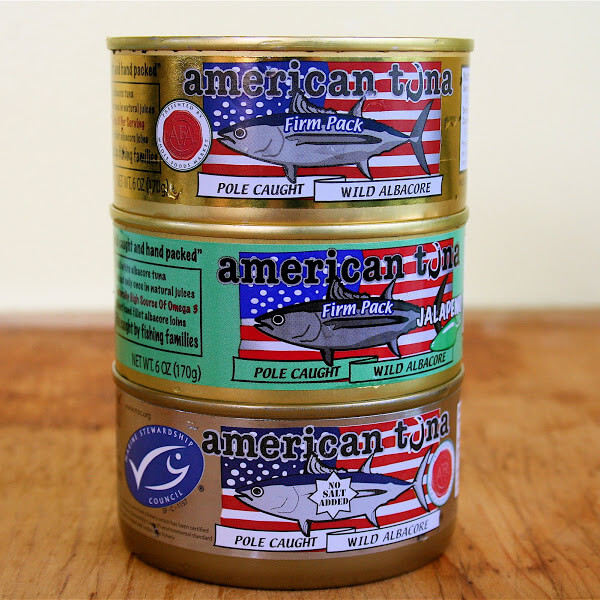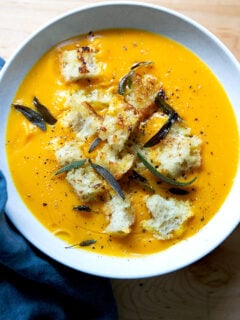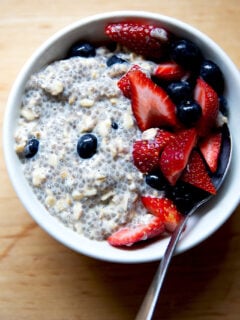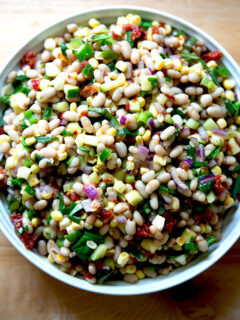American Tuna
This post may contain affiliate links. Please read my disclosure policy.
As I mentioned a couple of days ago, I’ve made a new discovery: American Tuna. Now, before you start freaking out that “women of child-bearing years should not be eating tuna,” give me a minute to explain. This tuna, caught in the Pacific Northwest, is young albacore tuna and unlike most of the tuna caught today, hasn’t had time to accumulate many toxins. Older albacores, blue fins and yellow fins — the varieties most often packed into cans today — can be over 40 years old and pose the biggest risk to consumers.
Let me tell you a little about this company, too. Six families make up the American Tuna fishery, which is based out of San Diego. Every June, the American Tuna fleet (five boats) departs the Port of San Diego and heads to the Pacific Northwest. These fishermen, each equipped with little more than a fishing pole, reel in young albacore tuna one at a time. (If you have a moment, visit the American Tuna Web site and watch them in action — it is amazing!) When their boats are filled, they deliver the tuna to canneries located along the coasts of Oregon and Washington. The fleet does not return to San Diego until November.
At the canneries, the fish are hand-filleted, hand-packed, canned and sealed. The tuna is cooked in the can in its own juices. Most canned tuna today has been cooked (often two or three times) as a whole fish and mixed with soy products, vegetable broth, pyrophosphate, salt, water and/or oil before being canned. American Tuna, in contrast, contains one ingredient: albacore tuna. (In the flavored varieties, however, garlic, jalapeno and salt are added in small quantities.)
American Tuna contains more omega-3 fatty acids than conventional brands. A two-ounce serving of American Tuna provides 2.6 grams of omega-3 fatty acids whereas a two-ounce serving of Starkist tuna provides 0.36 grams of omega-3 fatty acids. What accounts for the dramatic difference? Young albacore living in the cold waters of the Pacific Northwest have more body fat and therefore a higher amount of omega-3 fatty acids. When they migrate to warmer waters, they lose their body fat along with many of these beneficial nutrients.
What else can I say about this company? Oh, they belong to the American Albacore Fishing Association (AAFA), a family-run, 21-boat association operating out of San Diego, which the Marine Stewardship Council (MSC) recently certified as a sustainable fishery, making it the first and only tuna fishery in the world to bear this eco-label. MSC is an independent organization that promotes responsible fishing practices. Moreover, the Monterey Bay Aquarium’s Seafood Watch places North Pacific troll- and pole-caught tuna (such as American Tuna) on its “best choice” list.
If you are interested in learning more, read on: Tuna, At Last, Without All The Guilt, The Bulletin
Whole Foods Markets nation wide carry American Tuna.
Oh, and this tuna melt, packed with tarragon, was amazing.
Purchase American Tuna at your local Whole Foods Market.
Print
American Tuna
- Total Time: 15 minutes
- Yield: 4
Ingredients
- 2 tablespoons mayonnaise
- 1 teaspoon Dijon mustard
- juice of half a large lemon (about 1½ tablespoons)
- kosher salt
- freshly ground black pepper
- 1 6-ounce can American Tuna
- ¼ cup finely diced red onion
- ¼ cup chopped tarragon
- 1 loaf of bread, bakery-style French or Italian
- softened butter
- 1 tomato, thinly sliced
- 1 small bunch arugula
- grated cheddar cheese
Instructions
- Make the dressing: Whisk the mayonnaise with the mustard and lemon juice. Season with a pinch of salt and pepper to taste. Dressing will be thin. Taste, adjusting seasoning as necessary.
- Place tuna in a large mixing bowl. Add the onion and tarragon. Pour dressing over top and combine mixture gently with a fork. Set aside.
- Slice bread into eight rounds. Spread one side of each with the softened butter. Turn bread butter-side down. Begin assembling sandwiches: Place a small handful of arugula on four of the rounds. Top each with a mound of the tuna salad. Top tuna with tomato slices. Top tomato with cheese. Cover with bread.
- Heat a large nonstick skillet or griddle over medium heat. When hot, add a small dab of butter, then place sandwiches on the cooking surface. Cook until golden brown. Carefully flip each one, and cook on other side until golden brown.
- Remove from heat, cut in half, and serve.
- Prep Time: 5 minutes
- Cook Time: 10 minutes
This post may contain affiliate links. Please read my disclosure policy.















6 Comments on “American Tuna”
Amazing! I will look for this tuna on the East Coast. But I was wondering whether lead can leach into the fish from the solder in the can if the tuna is cooked in the can? Or is lead solder banned from cans now? Do you know?
The seafood manager at Whole Foods put me onto American Tuna last year, and I’ve been purchasing it whenever it seemed reasonable. The price (over $6 a can, last time I checked) makes it more of a special treat than something to spread over crackers or mix into a quickie sandwich. Thanks for all the information! I had been told they were a San Diego company, but then was also told that they fished off Baja. Makes more sense that they head up north.
This definitely does look amazing, and I’ll be looking for it on my next Whole Food’s visit.
Aren’t you glad you discovered Whole Foods???!
Fascinating – I will have to look for this in the store and try it out. It’s been a long time since I’ve had canned tuna b/c of the mercury issues!
I have learned something today, thank you.These tuna melts looks so yummee….
What fun to see this tuna showcased! My brother, Jack Webster, is one of American Tuna’s founders/boat operators (the Millie G). This tuna is worth ordering from their website if you don’t have Whole Foods in your area.